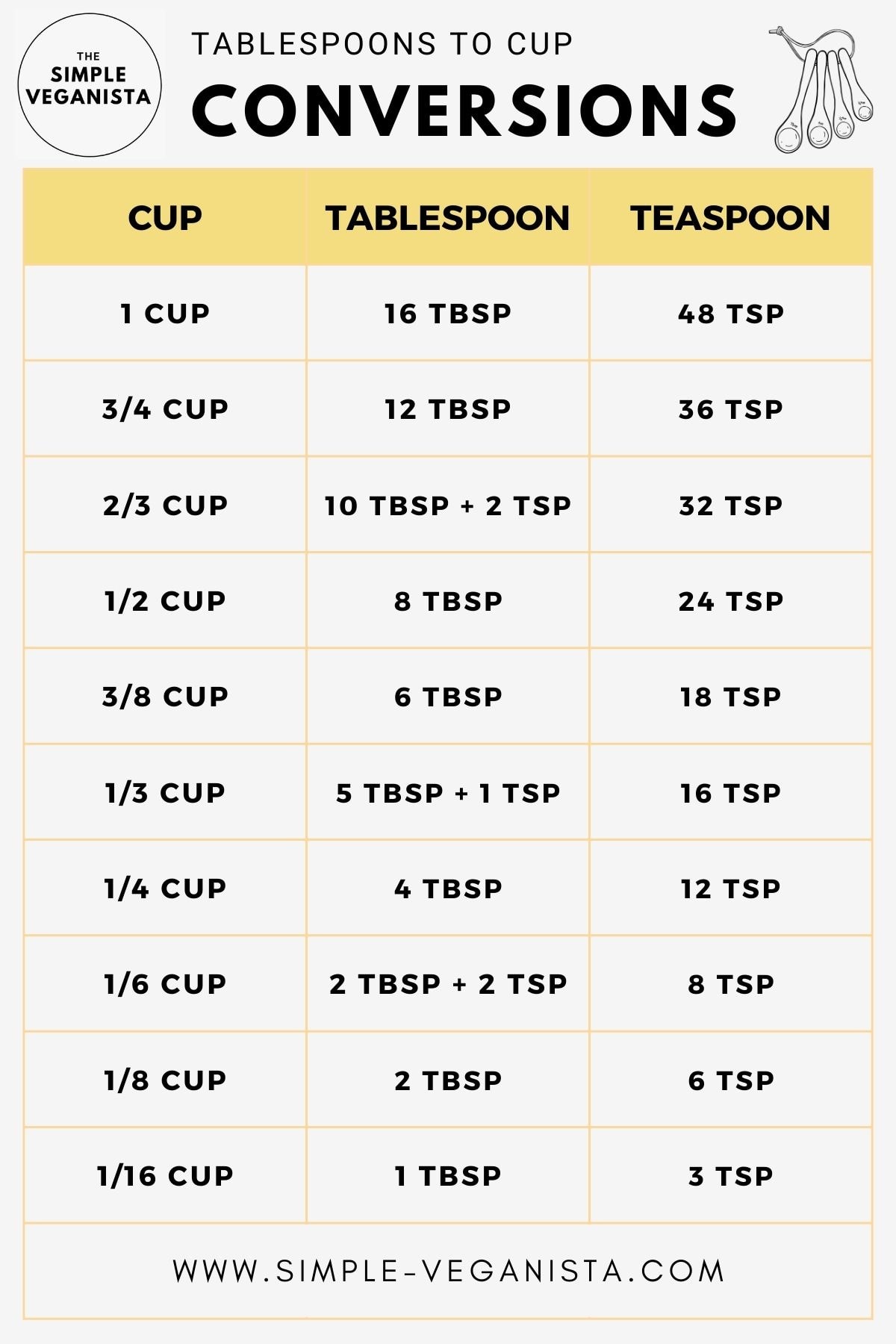4 Teaspoons to Cups: Quick Guide

Converting measurements is an essential skill for any cook or baker, and understanding the relationship between teaspoons and cups is crucial for achieving accurate and consistent results in the kitchen. This guide will delve into the specifics of converting 4 teaspoons to cups, providing you with the knowledge to make precise measurements for your recipes.
Understanding the Teaspoon to Cup Conversion

When it comes to measuring ingredients, teaspoons and cups are two commonly used units of measurement. A teaspoon is a smaller unit, often used for precise measurements of spices, extracts, or liquids, while a cup is a larger unit suitable for dry ingredients like flour, sugar, or nuts.
Converting teaspoons to cups involves a simple mathematical equation, but it's important to remember that the conversion factor depends on the ingredient you're measuring. Different ingredients have varying densities, which impact their volume and, consequently, the conversion rate.
Converting 4 Teaspoons to Cups for Liquids

Let’s start with liquids, which have a more straightforward conversion rate. A standard teaspoon, when filled level, holds approximately 5 milliliters of liquid. Therefore, 4 teaspoons of liquid equate to:
4 teaspoons x 5 milliliters per teaspoon = 20 milliliters
To convert this volume to cups, we use the fact that there are 250 milliliters in a standard cup. Thus, the conversion is as follows:
20 milliliters / 250 milliliters per cup = 0.08 cups
So, 4 teaspoons of liquid are approximately equal to 0.08 cups or 1/12 of a cup. This is a very small quantity, so it's important to use precise measuring tools when dealing with such small measurements.
Converting 4 Teaspoons to Cups for Dry Ingredients
When it comes to dry ingredients, the conversion rate is not as straightforward as it is for liquids. The volume of a dry ingredient can vary depending on how it’s packed or scooped into the measuring spoon. To ensure accuracy, it’s recommended to use a dry measuring cup and level off the ingredient with a straight edge.
As a general guideline, 1 teaspoon of a dry ingredient is approximately equal to 1/3 tablespoon. Therefore, 4 teaspoons would be roughly equal to 4/3 tablespoons. However, when converting to cups, the specific ingredient and its density must be considered.
For instance, let's consider two common dry ingredients: sugar and flour. Sugar is denser than flour, so it occupies less volume for the same weight. Here's how the conversion would look for each ingredient:
| Ingredient | 4 Teaspoons (by volume) | Cup Equivalent |
|---|---|---|
| Sugar | 4 teaspoons | Approximately 1/16 of a cup |
| Flour | 4 teaspoons | Approximately 1/8 of a cup |

As you can see, the conversion varies significantly between these two ingredients. This highlights the importance of understanding the specific ingredient's characteristics when converting teaspoons to cups.
The Impact of Precision in Baking
In baking, precision is key. Small variations in ingredient quantities can significantly affect the final outcome of a recipe. Accurate measurements ensure that your baked goods turn out consistently, whether you’re making cookies, cakes, or pastries.
When working with small measurements like 4 teaspoons, it's crucial to use the right tools. A set of precise measuring spoons, preferably with clear markings, will help you achieve accurate results. Additionally, investing in a good quality digital kitchen scale can provide even more precise measurements, especially when dealing with larger quantities.
Conclusion: Mastering the Art of Measurement

Converting 4 teaspoons to cups is a simple task once you understand the basics of measurement conversion. Whether you’re working with liquids or dry ingredients, knowing the specific characteristics of the ingredient and using the right tools can make all the difference in achieving precise and delicious results in the kitchen.
Remember, baking is a science, and accurate measurements are the foundation of successful baking endeavors. With this knowledge, you're well on your way to becoming a master of the art of measurement!
Frequently Asked Questions
Can I use a regular tablespoon instead of measuring spoons for small quantities like 4 teaspoons?
+While a regular tablespoon can be used for larger quantities, it’s not ideal for precise measurements like 4 teaspoons. Regular tablespoons can vary in size, and using one for such a small quantity could lead to significant inaccuracies. It’s always best to use a set of measuring spoons with clear markings to ensure accuracy.
Why is it important to level off dry ingredients when measuring them with a spoon or cup?
+Leveling off dry ingredients ensures that you’re measuring by volume accurately. When you scoop or pack dry ingredients, the volume can increase, leading to an inaccurate measurement. By leveling off the ingredient with a straight edge, you ensure that you’re measuring the true volume of the ingredient, not the volume of the heap or mound.
Are there any common mistakes to avoid when converting teaspoons to cups for baking recipes?
+One common mistake is assuming that all dry ingredients have the same volume-to-weight ratio. As we discussed, different ingredients have different densities, so it’s crucial to consider the specific ingredient when converting teaspoons to cups. Additionally, make sure to measure ingredients accurately, using the right tools and techniques, to avoid any baking disasters.



